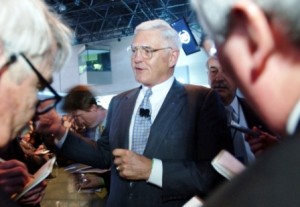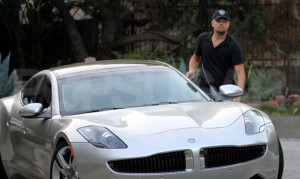General Motors’ former “car czar” and Vice Chairman Bob Lutz reportedly is part of a group making a bid to purchase the assets of fast-failing plug-in carmaker Fisker Automotive.
The $20 million offer would be part of a pre-packaged bankruptcy deal, according to the Reuters news service. Fisker, which produces the $100,000 Karma plug-in hybrid sports car, laid off three-quarters of its staff in April and senior executives subsequently told a Congressional committee that a Chapter 11 filing was quite likely to follow.
Credited with the original concept that eventually became the Chevrolet Volt plug-in, Lutz did not return a request for comment. But he recently expressed his interest in Fisker through a bylined column on the Forbes blog. He described the Karma as “quite possibly the most beautiful four-door sedan ever,” and referred to its underlying technology as “ground-breaking.”
The proposed deal would pair VL Automotive, a boutique automaker Lutz has a stake in, along with the Wanxiang Group, a Chinese automotive supplier.
(Fisker lays off most of its staff. Click Here for that story.)
Prior to the mass layoffs, Fisker was reportedly discussing various deals – which included both capital investments and complete acquisition – with several Chinese companies, among them Geely, the automaker that purchased Volvo several years ago.
Those potential partners pulled out, Fisker insiders told TheDetroitBureau.com, when the depths of the start-up maker’s problems became clear. Due to cash problems Fisker has not been able to produce any of the Karma plug-ins since last July. And it has been unable to complete development of its second product line, the Fisker Atlantic, which was supposed to take it into a more mainstream segment.
Meanwhile, it still owes $171 million to the Department of Energy for a low-interest loan. The DoE original agreed to a $529 million credit line but shut off the tap when it became clear Fisker was having trouble meeting key targets. The maker, in turn, has blamed the DoE’s decision for much of its current problems.
(Senior Fisker officials paint a gloomy picture for Congress. Click Here.)
The Fisker Karma went on sale in early 2012, just as fuel prices began a brief surge towards near-record levels. The vehicle was designed to run more than 30 miles in electric mode then fire up a small internal combustion engine, if necessary, to keep going. Its striking design and green halo won a number of high-profile customers including actor Leonardo DiCaprio and former Secretary of State Colin Powell – even though many reviewers, including TheDetroitBureau.com, faulted some of the car’s engineering.
(Consumer Reports has harsh words for Fisker Karma. Click Herefor more.)
The maker subsequently faced a series of recalls and service actions, including one to deal with a potential fire hazard involving a cooling fan and another to replace defective battery packs produced by Fisker’s supplier, A123 Systems.
A U.S. court recently approved the final plans for A123’s bankruptcy – the supplier falling victim to lower than expected demand for automotive batteries. Most of its assets have been acquired by Chinese supplier Wanxiang, which is now part of the group making a bid for Fisker.
It is unclear precisely what role Wanziang and VL Automotive would play if they acquired Fisker. VL showcased a model it called the Destino during January’s North American International Auto Show in Detroit. It squeezed a high-performance Chevy Corvette ZR1 powertrain into the body of a Karma, replacing the Fisker’s plug-in powertrain.
Curiously, Lutz has been an active proponent of “electrification,” including the Chevrolet Volt project, even though he is a vocal skeptic of global warming.
As its fortunes began to fail, Fisker Automotive hired a bankruptcy consultant to help the maker explore its various options. There are apparently other interested parties, according to Reuters and company sources.
One potential problem is that several members of Congress have expressed significant opposition to having Fisker and its technology sold to the Chinese. Meanwhile, it is unclear whether the DoE, which recently claimed $21 million in Fisker assets to offset the outstanding loan, might have any influence over a sale of the company.
(Energy Department seizes $21 million from Fisker. Click Here for more.)
During its brief life, Fisker claims to have raised $1.2 billion in private capital, along with the DoE loan funds. It turned to a contract manufacturer in Finland to produce the Karma but had hoped to build the Atlantic at an old GM plant in Delaware. While the Atlantic’s development program is far from complete, according to sources, a new owner could potential resume production of the Karma in short order.



A good looking car, especially an EV is only as good as the engineering, design and contruction involved. In addition the company needs to have the resources to produce and market the product for years before they can expect to be profitable. At $100K per copy the market becomes very limited and it’s no surprise that Fisker is headed for bankrupcy. IMO, Lutz will have his hands full trying to turn this operation into a profitable entity.
If Bob moves the company to Detroit and hires people that actually know how to design cars instead of the “architects” the whirling dervish prefers to hire, he will be able to produce a vehicle that not only makes sense but actually works.
Plus, you will not have to worry about them “bricking”.
Bob knows.